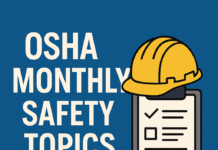
What Does OSHA Do?
Introduction to OSHA
Occupational Safety and Health Administration, commonly known as OSHA, is a federal agency established to ensure safe and healthful working conditions for employees in the United States. Since its inception in 1970, OSHA has played a crucial role in safeguarding workers across various industries.
OSHA’s Mission and Purpose
Definition of OSHA
OSHA’s primary mission is to prevent work-related injuries, illnesses, and fatalities by setting and enforcing standards, and by providing training, outreach, education, and assistance.
Historical Background
OSHA was created under the Occupational Safety and Health Act of 1970 during the Nixon administration in response to rising concerns about workplace safety and health hazards. It marked a significant milestone in ensuring workers’ rights to safe working environments.
Key Functions of OSHA
OSHA fulfills its mission through several key functions:
Ensuring Safe and Healthful Working Conditions
OSHA is responsible for developing and enforcing standards to ensure that workplaces are free from recognized hazards that can cause harm to workers. These standards cover a wide range of industries and workplace activities, from construction and manufacturing to healthcare and agriculture.
Setting and Enforcing Standards
OSHA sets standards based on thorough research, industry best practices, and input from stakeholders. These standards address specific hazards such as chemical exposure, fall protection, and machinery safety. Enforcement of these standards is conducted through inspections and penalties for non-compliance.
Providing Training, Outreach, Education, and Assistance
OSHA offers various resources and programs to help employers and employees understand and comply with safety regulations. These include training courses, educational materials, and consultation services to improve workplace safety practices.
OSHA Regulations and Compliance
Overview of OSHA Regulations
OSHA regulations cover a wide range of safety and health topics, including hazard communication, personal protective equipment (PPE), electrical safety, and ergonomics. These regulations are designed to protect workers from common workplace hazards and ensure their well-being.
Compliance Requirements for Employers
Employers are required to comply with OSHA regulations by providing safe working conditions, training employees on safety procedures, maintaining records of workplace injuries and illnesses, and cooperating with OSHA inspections.
OSHA Inspections and Enforcement
Process of OSHA Inspections
OSHA conducts inspections of workplaces to ensure compliance with safety regulations. Inspections may be initiated based on complaints, referrals, targeted programs, or random selection. During inspections, OSHA inspectors assess potential hazards, interview employees, and review records to determine compliance.
Consequences of Non-Compliance
Non-compliance with OSHA regulations can result in serious consequences for employers, including fines, citations, and penalties. Repeat offenders may face increased enforcement actions, including shutdowns or criminal charges in cases of willful violations.
Impact of OSHA
Reduction of Workplace Injuries and Fatalities
OSHA’s efforts have contributed to significant reductions in workplace injuries, illnesses, and fatalities over the years. By promoting safety awareness and enforcing regulations, OSHA has saved countless lives and prevented countless injuries.
Economic Implications
In addition to saving lives, OSHA’s work has significant economic implications by reducing healthcare costs, worker compensation claims, and lost productivity due to workplace accidents. Investing in workplace safety not only protects workers but also benefits employers and the economy as a whole.
Challenges and Criticisms
Limitations of OSHA
Despite its achievements, OSHA faces challenges in effectively regulating workplace safety, including limited resources, evolving hazards, and resistance from some employers. Additionally, the complexity of modern workplaces and the gig economy present new challenges for enforcement.
Criticisms from Various Stakeholders
OSHA has been criticized by various stakeholders, including employers, for being too restrictive or not stringent enough in its regulations. Labor groups often advocate for stronger enforcement and expanded protections for workers, while industry associations may push back against perceived regulatory burdens.
OSHA, which stands for the Occupational Safety and Health Administration, is a regulatory agency in the United States that ensures safe and healthy working conditions for employees. It sets and enforces standards aimed at preventing workplace injuries, illnesses, and fatalities. OSHA conducts inspections, provides training and education, and works with employers and employees to promote workplace safety and health.Conclusion
In conclusion, OSHA plays a vital role in promoting workplace safety and protecting the health and well-being of American workers. Through its standards, enforcement efforts, and outreach programs, OSHA continues to make significant strides in reducing workplace injuries and fatalities. However, ongoing challenges and criticisms highlight the need for continued vigilance and improvement in ensuring safe working conditions for all.
List of OSHA Standards for Safety
Occupational Safety and Health Administration
HSE Training Requirements in OSHA Standards
OSHA Certification Online Free
How to Get OSHA 510 Certification
Unique FAQs
- What industries does OSHA regulate? OSHA regulates a wide range of industries, including construction, manufacturing, healthcare, agriculture, and more.
- Can small businesses afford to comply with OSHA regulations? Yes, OSHA provides resources and assistance to help small businesses comply with regulations, and many compliance measures are cost-effective and beneficial in the long run.
- How does OSHA enforce its regulations? OSHA enforces regulations through inspections, citations, penalties, and outreach efforts to educate employers and workers about their rights and responsibilities.
- What is the penalty for OSHA violations? Penalties for OSHA violations vary depending on the severity of the violation, the size of the employer, and other factors, but can range from fines to criminal charges in cases of willful violations.





















